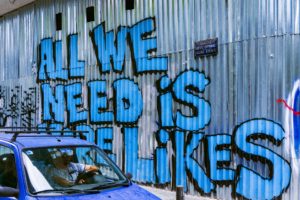Guest Post by Dr. Mark Drapeau – read his blog, follow him on Twitter

Source: Shutterstock Images
Publishing “top 10” lists is unfortunately a staple of modern journalism. But alas, writers must drive readers’ eyeballs, even when discussing serious topics like the government. And so we find a new list that mixes Web 2.0 with the government: “Top 10 agencies with the most Facebook fans.” For the record, this list is topped by the White House with 327,592 fans, followed by the Marine Corps, Army, CDC, State Department, NASA, NASA JPL, Library of Congress, Air Force, and Environmental Protection Agency. Congratulations to all these hard-working agencies.
But what exactly are we celebrating here? The fact that government agencies are embracing new technologies that the citizens they serve actually use? That’s nice I suppose, but everyone from Papa John’s Pizza to America’s Next Top Model (200,000 more fans than the White House, cough) to someone I met once at a party during Internet Week has a Facebook “Fan Page” now, so surely we are not celebrating the mere presence of them. In fact, when everyone in my social circle’s social circle asks me to become a fan of their long-standing charity, their favorite television program, or their single-person consulting firm, everything becomes a blur of meaningless, cheap invitations that become remarkably easy to decline. There is no value in simply having a fan page anymore. There may be street cred in not having one – time will tell.
Are we applauding the government’s fan numbers? The article leads with, “The White House currently has more fans than the Washington Redskins.” The most powerful global seat of power in perhaps the most recognizable office building in the world has more fans than the local football team? Earth-shattering. Let’s consider how popular the White House is. Facebook now has 300 million users; thus, approximately one out of every 1000 Facebook users is a “fan” of the White House. The other 999/1000 are not. And since many Facebook users live outside the U.S., one must assume that many White House fans do as well. Should every U.S. citizen using Facebook be a fan of the White House? Is that the goal? Who knows.
Still, the White House shouldn’t feel too bad about those stats. Rounding out the top 10, the EPA has convinced one of every 100,000 Facebook users to become their fans. Bravo. Let’s keep this in perspective. Soccer player Cristiano Ronaldo has two fan pages that total four million fans. Julia Allison, who isn’t even a real celebrity, has over 15,000 fans – if these numbers are in any way meaningful she’s roughly as popular as the State Department, the agency heading up U.S. foreign policy. These numbers seem even worse when one considers that there are hundreds of U.S. Federal Government departments and agencies, many of which haven’t a presence on Facebook or anything similar.
But perhaps I’m being too harsh. Let’s assume for a minute that these agencies are genuinely touching microniches and that the fans, whatever their numbers, are indeed fanatical about these agencies. What are they doing with that raving fan base? Not much. Sites like the Army and CDC and State Department primarily re-post their own news from their own websites. I didn’t see any original writing. I didn’t even see aggregation of information about, say, foreign policy from other sources. I certainly didn’t see any innovative contests from the Marine Corps, or crowdsourcing from NASA. And while there are fan comments posted on the pages, it’s not obvious at all what is being done with that feedback, if anything. Make fun of Tyra Banks all you want, but her show’s fan page has 286 discussion topics, hundreds of photos, headshots, names, and bios of people involved in the show, and listings of upcoming events. They’re so organized at America’s Next Top Model that we might consider asking them to inform people about the resurgent H1N1 flu virus. We might also consider hiring Bravo’s producers as government public affairs consultants.
If you think I’m joking about that, you probably have no business working with social media for the government.
The larger issue here is that the connection of any of these Facebook fan pages to agency goals and strategy is murky at best. As someone who spends a bit of time thinking about “Government 2.0,” it’s difficult to decipher how this is helping the government. True, the pages are somewhat informative, and to some degree they reach a citizen audience where they are. But it’s not novel and it’s not social and it’s not engaging. The execution is flawed, the tactics are questionable, the strategy is vague, and the goals are unclear. And all the government pages in the top 10 list effectively look the same. Monkey-see, monkey-do.
My personal Facebook page has about 2,000 connections, but this by itself is nothing to celebrate. The meaningful question is not about who has more fans, but about who can authentically and transparently – and usefully – interact with citizens to provide value and become the pulse of conversations. Here are some questions I have for governments and agencies running Facebook fan pages: What are the names of the people running the pages? What are their titles? What city is their office in? Where do they blog? Which events are they attending this year? (Can I meet them there?) How are you going to get your fans engaged in your mission? How can I tell you my stories about military service, or foreign travel, or amateur astronomy? Would those stories be helpful to you? How are you using social media like Facebook to get citizens involved in their government?
These are questions that departments and agencies, and private companies for that matter, should be asking themselves before they deploy official new media platforms like a Facebook fan page. The answers to these questions and others should be visible on day one. When the first White House memo of the new administration outlined the principles of a transparent, participatory, and collaborative government, this should have been obvious. It appears not to be so.





An excellent post that applies equally well to nonprofits, businesses and anyone else with a fan page on Facebook. From a strategic perspective, having a huge following is worthless if your only goal is to build a huge following. It’s the same problem on Twitter. If you haven’t first determined your objectives, who you want to connect with to achieve those objectives, and then a strategy for influencing or moving people to action once they arrive, then it’s all wasted effort.
It’s not just *many* people outside of US on Facebook – it’s the majority (70% according to the company). That would put around 9 million in the US. Let’s assume (always a bad idea, I know) that the fans of the White House are based in the US. That means something like 1 out of every 270ish Facebook users in the US is a fan of the White House (is that right or is my math terrible as usual?).
Since not every single US citizen is on Facebook and not everyone cares about politics or the government, I’ll take that number. It doesn’t change your point, though – what’s the point of celebrating the numbers? 🙂 They should be doing something useful with that audience.
<h1 style=”margin-top: 0px; margin-right: 0px; margin-bottom: 10px; margin-left: 0px; font-size: 27px; font-weight: normal; color: #565656; font-family: georgia, serif; line-height: 33px; padding: 0px;”>Fallacious Celebrations of Facebook Fans</h1>